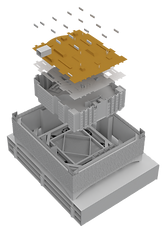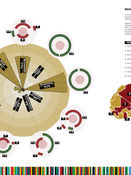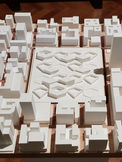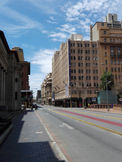TOL.
We are looking to collaborate content! Get in touch!
Rebirth Design Studio




The African Union Headquarters







Project Intent
By 2063 the African Union (AU), the governing body of Africa, has set a series of goals and objectives in a vision for the future of the continent and her people. This vision has been developed over years of prior summits involving a series of objectives that require completion in order for the total unification of the African continent.
My project is about the manifestation of this vision becoming a reality in the ever-volatile contemporary African environment. This culminates in a campus which becomes the headquarters for the African Union and it’s commission’s departments which stand as the various strands of concern and operation for the governing body.
The objectives of the African Union are; the celebration of history, maintenance of peace & decorum and the progressive discourse of Afro-lifestyle cultures.
My thesis 01 agenda covers research into the productivity and existing status quo of African countries, trying to decipher the levels of co-operation and types of political legislature that allow or prevent countries from collaborating.
Research Agenda
My thesis 01 agenda covers research into the productivity and existing status quo of African countries, trying to decipher the levels of co-operation and types of political associations that allow or prevent countries from collaborating.
This involved looking at the core operation establishment of the African Union and analysing the historic development in understanding the timeline the organisation had set for itself in achieving its passed goals.
Alongside this research, I looked at the top contributing representative states
that lead the continent productivity co-efficient in the economic, resource production, population and international relations department in order to establish a top 10 list of candidates that could take shape as a host nation for the 2065 Campus project.


Cultural Research
In the spirit of Africanism and African unity, I started looking at the colors of African flags and their representative symbolism. I wanted to attain a color palette which I could find the meanings of these colors on an African scale.
Part of the identity conditions within Africa come from the colors used for national flags. In Africa, a basic palette of colors is noted. Majority of the symbolism which these colors carry on a flag are associated to the Universal Improvement Association and African Communities League (UNIA-UCL) .
In Africa, a strong form of diversification from one culture to the next can normally be found in the cultural, religious and habitable differences one tribe would represent from the other.
These patterns weren’t only reflected in drawings prehistorically documented but also in forms of clothing and architectural structures as a way of manifesting cultural/lifestyle formalities.

Development in Patternity
Within the discourse of pattern design, there are a series of ways to group and categorize different pattern styles. For the relevance of this exploration, I have used the major differentiators between patterns that stand as ‘geometric’ and others which are ‘symbolic’.
Geometric patterns refer to the use of shapes, lines and other forms of curve and organic typologies which can be repeated in orientation and/or juxtaposition.
Symbolic patterns are more legible to the extend that these have more man-made references and natural objects such as fruit, animals or trees used emblematic-ally to create a motif.




Location
The Banking, mining and transport zones through out the CBD were given separated areas for development as part of a localization policy for various economic activities. As such, modern day Johannesburg still reflects many of these localized industries with Banks, government administration buildings, university campuses and more each having districts set to serve the function of the industry.
As part of the 2063 agenda, the AU executive commission are looking at exploring avenues where by industries involving economic strategies can be coupled with infrastructure and natural resource management to create new phases in developing skills and the African landscape.
In the spirit of Urban planning and my intervention’s ability to manifest an architectural expression of Afro-future ideals, I believe that the provision of all the Buildings for the African Union Commissions should be localized into a campus. This would support the 2063 agenda for knowledge transfer between not just industries but nations, under ‘one roof’ being in the AU Commissions campus.
The images aside flows through the analysis of the Johannesburg CBD context and explore the opportunities available for buildings to be adopted in a contemporary approach in the provision of existing structures for refurbishment and fitting to the Union's administration.
Design Development
Conceptually, I designed the campus to comprise of 3 buildings. Each building accommodated for the intents of the organisation in their past, present and futuristic prospects. The campus dissects into 3 buildings:
1. A new build for the Administration of the African Union
2. A repurposed colonial building for The African Union Free Trade Zone Association and,
3. A refurbished heritage building as the organisation's new data centre.





Development Plan
Campus Concept
Development Plan
Existing Context
Administration Building
The Admin building stands as the face and administrative structure of the campus. It entails a public entrance foyer, processional chamber for summits, a public concourse for further public activity as well as offices that fulfil the requirements of the organisation.
Conceptually designed with a series of thresholds that create an interaction between the public and private spaces, the building becomes a tool in expressing the open nature of the organisation whilst also it's endeavour to create opportunity for public participators.

Admin Building

Processional Chamber Section Plan

Public Concourse Section Plan

Admin Office Section Plan

Chamber Exploded Axo

Concourse Exploded Axo

Offices Exploded Axo
Culture Center
The ideals of the African Union creating a Trade organization to support the ever expanding market industry has been a long time coming. The discourse of this buiolding looks at the re-adaptation of an existing colonial and heritage building in Joburg CBD to become a tool for the cultural and trade development of the organisation.

Culture Center

Culture Center Exploded Axo


Structure and Landscape Strategy
Data Center
The Ngaga Data center comes out from a necessity for the African Union to extend their investments in the digital and technological framework.
From this, the support of a technological foundation would provide the union with the necessity to connect their organisation departments with each state represented whilst also giving them a contemporary edge to set the standard in the network extension that Africa should be aspiring to, to connect the continent under the conceptual context of the 2063 borderless continent agenda.


Exploded Axo
Exploded Components

Facade Zoom

Facade Section
Facade Section
Visuals










































